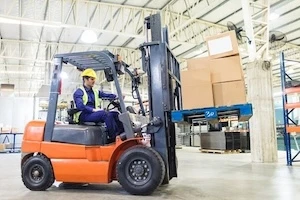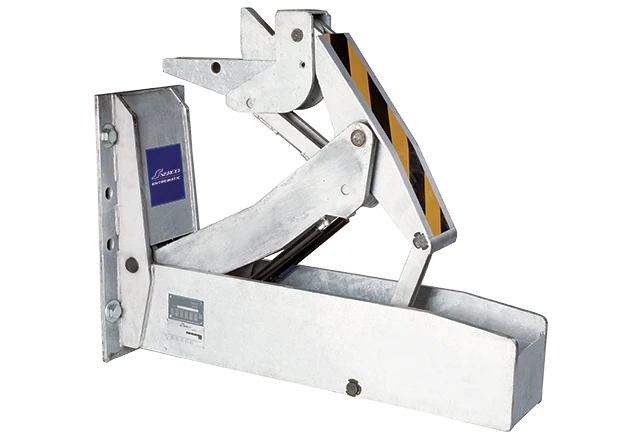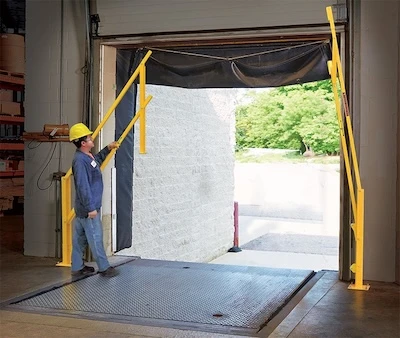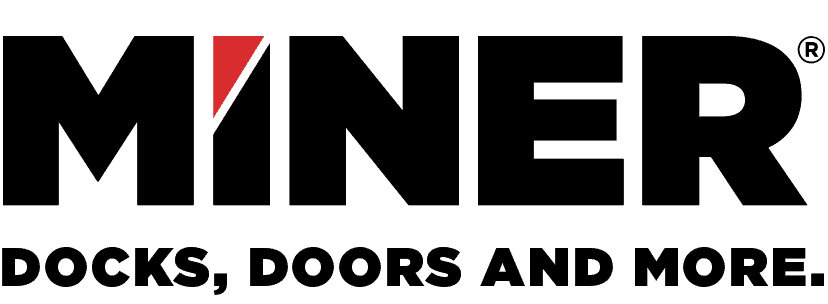LOADING DOCK Safety for your facility
Safeguard employees on your loading dock with equipment, policies and best practices.
Understand the Importance of Loading Dock Safety
As the operator of a commercial building, you are responsible for creating a safe environment for your employees. This rings especially true on the loading dock, where workers commonly perform their tasks alongside powered forklift trucks on elevated platforms, dealing with heavy equipment.
Focusing on dock safety is essential for the health, safety, and morale of everyone involved, as well as the overall effectiveness of your warehouse or distribution center. To deliver a safe and secure environment, you can work with an expert partner like MINER® to strengthen your approach to dock equipment selection, installation, maintenance, and repair.
More effective service for loading dock assets, including dock plates, vehicle restraint systems, and dock door assemblies, can reduce potential hazards. Other useful practices deal with the human element, such as safety training for all workers.
Dock accidents are devastating for everyone involved. Enforcing loading dock safety practices gives you the best chance of preventing these incidents and keeping a spotless safety record. You should do more than comply with Occupational Safety and Health Administration (OSHA) regulations— an ideal dock safety program goes beyond the baseline.
The right strategy for safety in the loading dock area will combine multiple methods, generating a true culture of safety for your facility. Working with MINER to safeguard your people and equipment can even deliver powerful returns, because safety awareness and productivity tend to go hand in hand.
LOADING DOCK SAFETY: WHAT DOES OSHA REQUIRE?
OSHA requirements around the loading dock area are relatively straightforward. They are the bedrock on which more sophisticated worker safety programs are based. The agency’s main stipulation about all work environments is that the area must be safe and healthy for employees to complete their tasks.
You can work with MINER’s experts to assess the safety of your loading dock area. Following the safety assessment, the next step is implementing equipment and design features that will not just comply with OSHA regulations but go further, creating a safe and productive environment. MINER’s factory-trained experts collaborate with facility managers to deliver effective, tailored solutions.
Around the loading dock, this can mean setting up fall protection railings around the dock edge to prevent injuries caused by accidental slips — OSHA calls for fall protection around any edge four feet or higher. Pedestrian safety for loading dock workers can also involve mapping out safe paths for employees on foot and lanes for forklift truck operators.
Specific areas with their own OSHA regulations include forklift trucks. These regulations also encompass standards for loading and unloading trucks, trailers, and train cars at the loading dock.
Forklift Operation and Safety Training
Forklift safety depends on several factors, with OSHA specifying in rules and clarifying letters that a forklift operator must be trained to use the vehicle effectively.

Loading and Unloading
Trucks, trailers, and train cars being loaded or unloaded need to have vehicle restraints in place to keep them from moving unexpectedly away from the loading dock. Wheel chocks are a minimum, and more advanced systems are available.

Loading Dock Plate Systems and Dock Levelers
All loading dock equipment used to bridge the gap between trailers and the dock itself must have the capacity and endurance to handle the loads that pass over them, including both forklift trucks and cargo

Electrical Safety
OSHA electrical safety requirements include:
- Installation in a “neat and workmanlike manner” and per instructions. Equipment that requires airflow must also have ventilation not blocked by walls, and outside assets must be guarded to prevent accidental shocks.
- Maintenance and repairs to keep equipment in top condition. It’s against OSHA regulations to use assets if they are damaged in a way that could affect their safe operation.
- Clear, undamaged markings and warnings on powered equipment that convey voltage, wattage, current, and more details.
- Physical guarding and enclosure for equipment operating at 50 volts or more. The enclosures should be clearly marked with warning signs.
By following OSHA regulations, you can guard your loading dock and workers against a variety of hazards. However, these rules are more of a starting point than a comprehensive guide. Other loading dock safety tips can take you beyond basic compliance to create a more secure facility overall.
Quick Tips: Loading Dock Safety Musts
Meeting and exceeding OSHA requirements around loading dock safety means following common-sense principles. These include:
- Training all employees: Everyone working on or near the dock should understand their responsibilities.
- Overseeing forklift operations: All forklift operators need training on the vehicles, and the environment should contain controls like warning paint and safety lips to guard against falls.
- Managing dock plates and levelers effectively: Employees must know the capacity of dock plates and levelers and secure equipment firmly in place whenever it’s used.
- Cleaning and drying dock surfaces: Frequent attention to the dock surface is important to prevent slip-and-fall hazards, and the area should always be clear of debris.
- Securing vehicles: Essential safety considerations around trucks include the use of vehicle restraints and the segregation of pedestrian and automotive areas.
Start Right Now!
Start Right Now!
Spotlight: Loading Dock Safety Equipment
Several of the loading dock hazards workers deal with every day can be addressed through the use of specialized equipment. MINER can help you choose the right assets for your dock area, starting with a loading dock safety audit to determine where you could improve your performance. Potential assets to focus on include:
Dock bumpers: Bumpers to prevent hard collisions between trucks and the loading dock are a simple baseline for safe loading and unloading.
Vehicle restraints: Built-in trailer restraint systems can prevent roll-away danger and keep personnel safer when moving between trucks and the dock.
Dock lights: Light signals can give clear information to drivers and other personnel, protecting against dock accidents.
Dock safety barriers: Guardrails around high loading dock edges and other edge guarding systems can protect against falls.
WHY FOCUS ON LOADING DOCK SAFETY AWARENESS?
An enhanced focus on loading dock safety practices can have wide-reaching effects on your employees. The commonly cited industry data holds that 25% of industrial accidents occur on loading docks, and reducing the incidence rate of these incidents is a powerful way to keep your team healthy, happy, and effective.
The suffering associated with loading dock injuries is self-evident, and preventing these occurrences should be a top priority for every facility operator. It’s also worth noting that even incidents where no one is hurt can have a negative impact on overall performance.
When equipment suffers an unexpected breakdown or failure, that can bring productivity on the loading dock to a halt. The whole supply chain can suffer delays as workers attempt to resolve the issue. Therefore, increasing the reliability of equipment and preventing unexpected downtime is relevant from both personal safety and logistics productivity perspectives.
It pays to consider safety from an employee morale perspective. Workers gravitate to workplaces where their safety and comfort are priorities. A facility that doesn’t display clear consideration for its employees can have trouble attracting and retaining top performers, leading to further productivity issues.
There are numerous ways to build loading dock safety awareness, each capable of having a powerful impact on the effectiveness of your loading dock crew. Some of these focus on your people — training, preparation, and day-to-day leadership are key elements in worker safety. Others revolve around equipment. When you have suitable, well-installed, properly maintained equipment, safety comes naturally.
LOADING DOCK SAFETY AWARENESS BEST PRACTICES: WHAT SHOULD YOU KNOW?
While the exact methods of keeping workers safe in the loading dock area will vary between facilities, there are a few loading dock safety tips that apply universally. For example, you can work with MINER on a loading dock safety audit to detect and correct any potential hazards around your facility.
MINER’s safety methodology encompasses:
Inspection
Taking stock of your current loading dock safety with an audit is important. What practices are in place? Are you using fall prevention systems on all ledges? Is the equipment in place suitable for its intended use? These questions and more can guide you through the process of improving loading dock safety.
Clearing Area
One of the most basic but impactful practices to apply in the dock involves cleaning up any obstructions. Clear — and clearly marked — paths for both powered forklift vehicles and employees on foot are critical for safe movement. The area should also be dry to avoid slip-and-fall hazards. Dock seals and shelters can help in this regard.
Equipment Maintenance
A proactive maintenance program for all your equipment, paired with emergency repair services as needed, can keep your personnel safe and efficient. Using data-based insights to maintain equipment before it suffers a breakdown is a key way to prevent unplanned downtime and dangerous incidents.
Training and Education
Every worker who serves near the loading dock should receive training that applies to their specific role. For instance, forklift operators must know how to safely operate their vehicles in a variety of circumstances, and shift supervisors should understand how to verify their team members are following correct practices.
Creating a safer loading dock area relies on a combination of people, processes, and equipment. When you have an expert service provider on your side, it’s simpler to achieve this overall level of excellence and keep your facility running smoothly.
FIND A LOADING DOCK REPAIR PROVIDER NEAR YOU
FIND A LOADING DOCK REPAIR PROVIDER NEAR YOU
GET STARTED CREATING A SAFER LOADING DOCK
As a national service provider, MINER can make significant contributions to safety-promoting features around your loading docks. When every piece of loading dock equipment has been chosen to meet your needs, installed professionally, and maintained frequently, you’re set up for success. MINER’s factory-trained technicians can also provide emergency repair service as needed.
A loading dock outfitted with the right equipment is ideally prepared for day-to-day safety and is, therefore also a key element in employee engagement and morale. Every asset, from loading dock levelers to commercial doors and dock seals, deserves attention. With MINER, you have access to the best options from a variety of top original equipment manufacturers.
AT A GLANCE: FREQUENTLY ASKED QUESTIONS
What regulations apply to the loading dock?
OSHA’s standard regulations around facility safety apply on the loading dock. Relevant rules include the need to guard against falls, closely monitor forklift use, and maintain all equipment.
How can I make my loading dock OSHA compliant?
Starting with a safety audit to determine your needs, you can install new equipment, implement training policies, and set up maintenance for all your assets. An expert partner like MINER can help.
What Are the Main Safety Hazards on Loading Docks?
The constant movement of people, vehicles, and heavy loads on the dock is a risk factor. It’s important to ensure people and vehicles all have space to maneuver safely, and that equipment is well-maintained and capable of standing up to the weight it will carry each day.
How Can You Quickly Improve Loading Dock Safety?
To improve loading dock safety on a day-to-day basis, it’s important to focus on issues such as debris scattered on the dock area or wet floors. Keeping paths clear for employees can reduce the chance of a workplace accident.
What Equipment Improves Loading Dock Safety?
Loading dock safety equipment includes:
- Vehicle restraint systems.
- Loading dock bumpers.
- Dock lights.
- Dock safety barriers.
A dock safety audit can determine whether your current loading dock safety equipment is up to acceptable standards.
